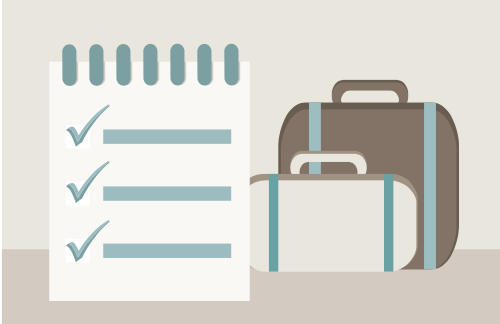2 Protect your accounts while traveling
While shopping or dining in a new city or country, you may swipe your debit or credit cards often. Consider using tools that help protect your card transactions from fraud while you travel. For example, when turned on, your phone’s location services may be able to verify card transactions when you make a purchase in an unusual place. Bank of America no longer requests that customers set travel notifications, due to ongoing security efforts that include monitoring your accounts and sending automatic alerts to your phone or email if suspicious activity is detected. Just make sure your bank and credit card company have your email address and mobile phone number so you can be reached while you’re traveling.
3 Sign up for mobile or online banking
Many people do some of their banking online or through a mobile app. But for the frequent traveler, online and mobile banking are invaluable ways to monitor and manage your accounts from almost anywhere, including the beach. Just remember, it’s important you know the answer to your online banking security question—you’ll need it if you log in from a new computer.
6 Take extra precautions when going abroad
If you’re traveling internationally, take steps to ensure you can safely access your accounts from outside the United States. It’s a good idea to prepare your PIN before traveling abroad. Some international ATMs only support four-digit PINs. Be sure your PIN does not start with a zero and know your PIN by the numbers, as some foreign ATMs do not have letters on the keypads. Some foreign card readers may require you to use a PIN with your credit card. In these cases, you’ll need to use the PIN assigned to your card, so make sure you know it ahead of time. Try to memorize your PIN and avoid writing it on your card or keeping it in your wallet.
8 Make sure your credit cards are travel-ready
Bring at least two valid, permanent cards with you on your trip, in case one gets lost or stolen. Keep in mind that temporary cards don’t always work, and replacement cards can take several days to arrive. Double-check the cards’ expiration dates, and write down the numbers for customer service; keep them in a separate, safe place in case you need to call them for any reason. If you’re traveling internationally, look into a bank or other issuer of chip cards, as the chip data is more difficult to capture for a new fraudulent card to be used elsewhere. You may even consider adding eligible debit and credit cards to your device’s digital wallet to pay for purchases using a virtual card number on your phone so merchants don’t receive your actual card number.
9 When it comes to cash, plan ahead
If you’re traveling domestically, it’s a good idea to make sure you have cash on hand in case your bank doesn’t have locations or ATMs where you’re headed. If you’re traveling internationally, you’ll probably want to order foreign currency ahead of time. This way, when you land, you’ll have local currency ready to go so you can pay for taxis, snacks and other incidentals without having to track down a currency exchange.
10 Find out where you can bank locally
Your bank may not have a location or ATM convenient to where you’re traveling, even if the bank is a national chain. Look up the closest location to your destination. This is true of international travel as well. If you’re headed abroad, check and see if your home bank has partnered with banks abroad. Using a partner bank’s ATM may help you avoid certain fees. Generally, you can find your bank’s partner network on its website or by calling. Bank of America’s locator allows you to search for international partner ATMs.
Analysis
This article gives a lot of good insights on the best ways to avoid trouble with spending while you’re abroad. Avoiding fraud appears to be the main goal, though every time you swipe your card, you’re pretty much exposing yourself as a potential victim. The best countermeasure appears to be online precautions put in place before you leave, where you can verify your identity and have access to your account. Another good precaution is to have doubles of anything important, like coming with 2 credit cards or a digital wallet to ensure you always have a way to pay for something. And you have to remember to check where your card is compatible and whether or not it has international fees. Then the question becomes whether or not you need cash, and this article says yes – they even say to exchange currency before! There are a lot of ways to tackle safe spending while abroad, and a lot of it lies in precautionary actions. I’m wondering if there is a way to consolidate them all into one place, or even a few easy steps?
Source
Better Money Habits. (2022, December 13). Travel checklist for a worry-free vacation. https://bettermoneyhabits.bankofamerica.com/en/saving-budgeting/travel-checklist




